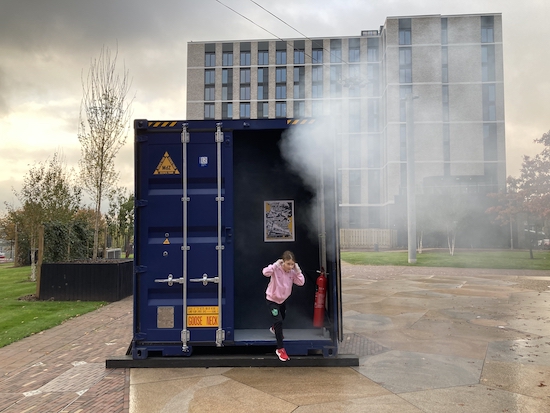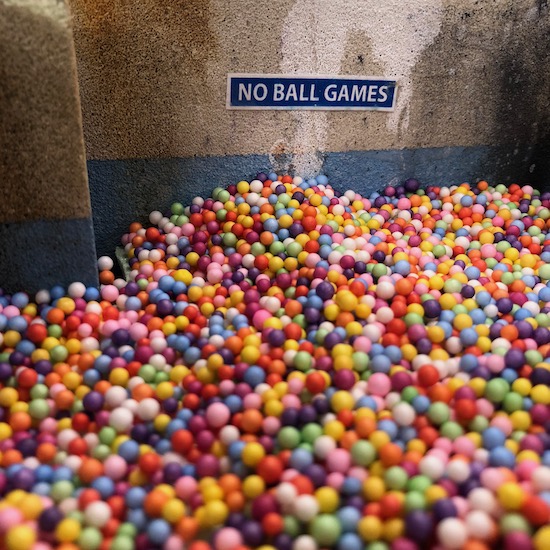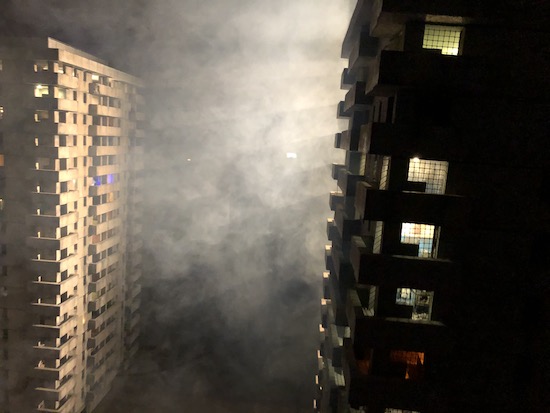On the north side of Edinburgh, on the border of the Muirhouse and Pilton housing schemes, the blades of a chinook attack helicopter shudder overhead, spreading panic below. In the concrete tower blocks around us, signal fires burn and decay and destruction is everywhere. Floors and walls are smashed into rubble, unattended televisions glow in the darkness, the remains of an ad hoc hospital are visible.
“HMP Camp Delta-Zulu Block D High Security Childrens Prison” is stencilled on the side of one block, cuddly toys visible through the caged windows. It looks like a bomb has gone off in the ball pit. Dazed, we make our way through the smoke-laced air of this crumbling brutalist hellscape, wondering what disaster took place here that forced the authorities to cage the population amid the ruins. Or maybe they didn’t need to be forced?
Then we glimpse daylight, and we’re back in the summer fresh air again, standing in the car park behind the municipal North Edinburgh Arts Centre. Would we like to buy any merchandise from the show? A well-stocked trestle table of programmes and memorabilia is laid out before us.
Our ten-minute descent into dystopia in the converted forty-foot shipping container behind us came courtesy of artist and sometime co-founder of the KLF and the Orb, Jimmy Cauty. ESTATE is the third part of a triptych, after his previous works Riot in a Jam Jar and The Aftermath Dislocation Principle (ADP). The latter featured at Banksy’s Dismaland and toured sites of historic riots around the country in its own shipping container, with a million people reportedly having already seen the open-access artwork.
While both of these model village dystopias were built to 1:87 scale, ESTATE is 1:25, meaning it’s small enough to walk around in, whereas ADP was viewed from portholes drilled into the container. Each of the four concrete tower blocks within weighs a ton, and is packed with electronic equipment which can operate at temperatures of minus forty degrees. This means that – just like ADP – ESTATE can tour around the country with minimal maintenance.

“As with the ADP Riot Tour, we rely on groups of interested and proactive people to act as hosts for the containers,” says Cauty. “If they can find a suitable site and have the ability to operate and encourage engagement with the work, we’ll send it to them. In Edinburgh it’s a group called Society of the Spectacles that orchestrated everything, found the site, hooked up with North Edinburgh Arts and published their own book for the occasion.
“We like to have our containers out there in the real world interacting – we want them to go where no other art can go. That way they pick up battle scars, graffiti and new meanings along the way. If they survive there will be plenty of time to show what’s left in a gallery at the end of the various world tours.”
There’s one part of our description which Cauty disagrees with. “ESTATE isn’t about any kind of dystopian future, it’s based firmly in the here and now,” he tells us. “I like to describe the current political situation as a ‘total shit show’. ESTATE in some ways reflects this and I don’t think I need to elaborate on that.”
Cauty knows what’s going on here, in the world of the ESTATE, but it’s up to each viewer which narrative they want to overlay as they work through the ‘Live-Work-Die units’ of Iceni Heights and the residential care home and human experimentation site Roman Point (“the only care home facility in the world that wasn’t adversely effected by the COVID-19 pandemic – but only because everyone was already dead”).
“On tour, the kids from the local estates love seeing the wanton destruction of an environment that looks like their home town, or people can come up with their own ideas about what’s going on,” he says. “There are clues to follow by watching the news bulletin that’s playing on the TVs in some of the flats or by reading the visitor guide, but my own narrative goes something like this…
“Brenda the teenage queen of the Iceni tribe and her kid brother Brendon are in charge, they live in Iceni Heights. They organise a mass breakout from Camp Delta Zulu, the high-rise children’s prison. The (so-called) Iceni tribe paint themselves blue and launch night-time raids on the other tower blocks in search of kittens and packets of crisps. They drive out the residents, destroy the flats and build a stone circle on the top floor of Tower Block 4. They did something bad in Roman Point care home but no one is saying anything. So far Amber Rudd and the North Kent constabulary have not been able to apprehend Brenda or Brendon.”

Rudd was Home Secretary in 2018, when Cauty started making the show, and he hasn’t been able to update the narrative to include the new Home Secretary, so he’s given the former a new job. “She now spends her time tearing around Kent in a chinook helicopter shouting authoritarian messages over the on-board PA system at the children below.”
Cauty seems enthusiastic about both his position outside the contemporary art world, and of ESTATE’s position as a work which people who will never approach a city centre contemporary art gallery can stumble upon and experience. “I haven’t, as far as I know, been nominated for the Worst Artist of the Year award, so I guess I’m doing quite well,” says the sixty-four-year-old.
“As far as I can work out, to make headway in the traditional art world you need to play by the rules – even though Rule One is to look like you’re breaking the rules and be friends with at least one person who went to Eton. I think it’s fair to say we (L-13 and me) operate in our own made up artworld universe that doesn’t measure success in units sold to millionaires, but in other, more mysterious and totally impractical ways.
“ESTATE isn’t really about me or the things I’ve been involved in,” he continues. “In some ways it could have been made by anyone. A bunch of kids from the local town won’t care I was in a rave heritage band from the last century, for them it will be about the thrill of seeing a representation of their home town totally smashed up and destroyed just for the hell of it. You don’t need a degree in art and you don’t need to know anything about me to get something from ESTATE.”
I ask him what the best thing anyone’s said to him about ESTATE is, and Cauty recalls a ten-year-old child’s words while he was visiting the site in Edinburgh (which is now cleared, with ESTATE moved to Glasgow for this month):
“Mate, what is it?”
“It’s a model village,” Cauty replied.
“But what’s it for?”
“It’s not for anything.”
“Sick.”
Jimmy Cauty’s ESTATE is now in the car park of Platform at the Bridge in Easterhouse, Glasgow, until Friday 30 July.


